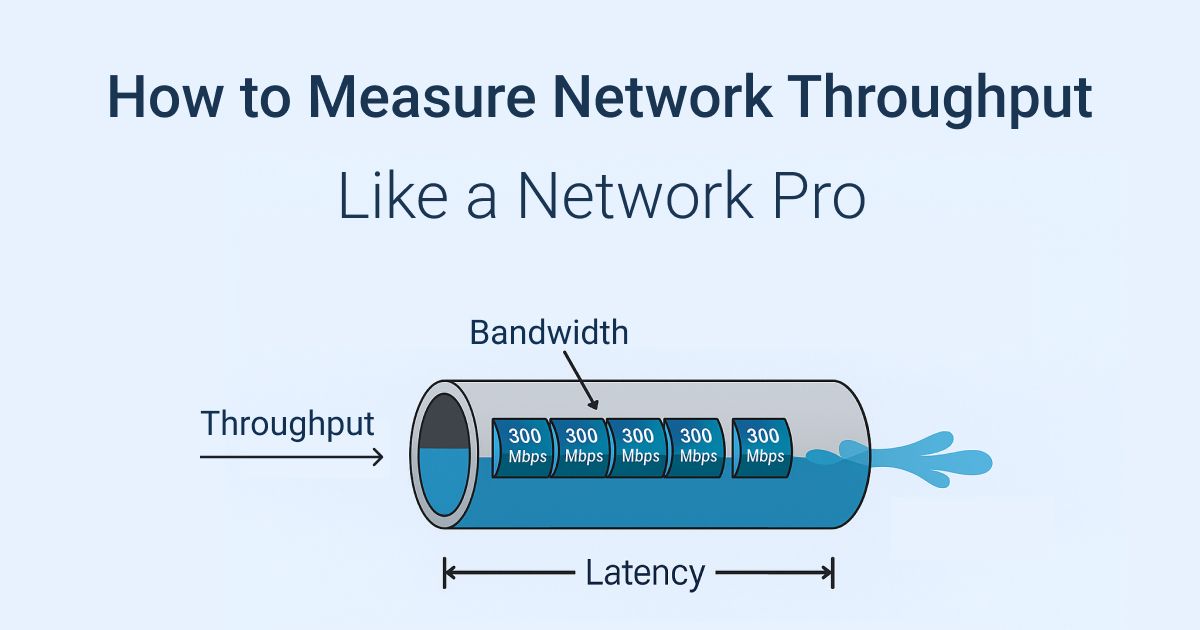Table of Contents
Table of Contents
For businesses managing large enterprise networks, network performance is critical for productivity and seamless communication. To ensure optimal operations and user experience, accurately measuring your network's bandwidth is key.measurements.
Measuring bandwidth goes beyond assessing Internet speed. It involves quantifying data transmission capacity within a given timeframe, essential for capacity planning, identifying bottlenecks, and making informed infrastructure decisions.
However, accurate bandwidth measurement can be challenging due to network dynamics and various factors. That's why understanding available techniques and tools is crucial.
In this post, we'll delve into effective bandwidth measurement techniques for businesses. We'll cover active and passive approaches, their benefits, limitations, and suitable use cases. Additionally, we'll introduce specialized tools that enable reliable network bandwidth measurements, empowering data-driven decisions and infrastructure optimization.
Bandwidth, in the context of computer networking, refers to the maximum data transfer rate or capacity of a network connection. It represents the amount of data that can be transmitted over a network within a specific time frame. Bandwidth is typically measured in bits per second (bps) and is a fundamental aspect of network performance.
Think of bandwidth as a pipe through which data flows. A wider pipe (higher bandwidth) allows more data to pass through at a given time, resulting in faster data transmission. Conversely, a narrower pipe (lower bandwidth) restricts the amount of data that can be transmitted, leading to slower speeds.
Understanding the available bandwidth of a network is crucial for network capacity planning, optimizing network performance, and ensuring that sufficient resources are allocated to handle the data requirements of connected devices, applications, and users.

Bandwidth determines how quickly data can be transferred between devices, servers, or across the Internet. It impacts various aspects of network performance, including download and upload speeds, streaming quality, website loading times, and overall user experience.
It's important to note that bandwidth can vary depending on the type of network connection. For example, an internet service provider (ISP) might offer different bandwidth options, such as 100 Mbps (megabits per second) or 1 Gbps (gigabits per second), to cater to different user needs and demands.
Bandwidth utilization, also known as network utilization, refers to the percentage of available network bandwidth that is currently being used or consumed by data traffic. It measures how efficiently the network's capacity is being utilized at a given time. Bandwidth utilization is a critical metric used to gauge the level of network congestion, the efficiency of data transmission, and the overall performance of a network.
For example: If a network connection has a bandwidth capacity of 100 Mbps (megabits per second) and is currently transmitting data at a rate of 50 Mbps, the bandwidth utilization would be 50% (50 Mbps / 100 Mbps * 100%).
High bandwidth utilization is not necessarily a problem if the network is designed to handle peak traffic. However, consistently high utilization levels can lead to network congestion, packet loss, increased latency, and a decrease in data transfer speeds. It can affect the overall performance and responsiveness of applications and services running on the network, impacting user experience.
Monitoring bandwidth utilization is crucial for network administrators to identify potential bottlenecks, plan for capacity upgrades, and optimize network resources. By analyzing bandwidth utilization trends over time, administrators can make informed decisions about network improvements and ensure that the network can handle current and future data traffic demands effectively.
Additionally, it helps in proactive management, allowing administrators to address congestion issues before they significantly impact users and services.
 Screenshot from Obkio's Network Monitoring Tool
Screenshot from Obkio's Network Monitoring Tool
Bandwidth is measured by sending data packets between two network points and calculating the transfer rate over time. The measurement process involves: (1) establishing a connection between source and destination, (2) transmitting a known amount of data, (3) recording the time taken, and (4) calculating throughput in bits per second (bps). This can be done using synthetic traffic, actual network traffic analysis, or SNMP polling of network devices.
- Generate traffic: Send data packets between two network points
- Time the transfer: Record how long data takes to travel
- Calculate rate: Divide data volume by transfer time
- Report results: Express as bits per second (Mbps/Gbps)
When measuring bandwidth, various units of measurement are used to quantify the speed at which data is transmitted over a network. Here are some common units of measurement for bandwidth:
- bps (bits per second): The bit is the smallest unit of digital information and represents a binary digit, either 0 or 1. Bandwidth is often expressed in bits per second, which refers to the number of bits that can be transmitted or received in one second. This unit is commonly used for measuring network speeds at a granular level.
- Kbps (kilobits per second): The kilobit is equal to 1,000 bits. Kbps is a unit used to represent the transmission speed of data in thousands of bits per second. It is often used to describe lower bandwidth connections, such as dial-up or older DSL connections.
- Mbps (megabits per second): The megabit is equal to 1,000 kilobits or 1,000,000 bits. Mbps is a unit used to represent the transmission speed of data in millions of bits per second. It is a commonly used unit for measuring network speeds, including typical residential broadband connections.
- Gbps (gigabits per second): The gigabit is equal to 1,000 megabits or 1,000,000,000 bits. Gbps is a unit used to represent the transmission speed of data in billions of bits per second. It is commonly used for measuring high-speed network connections, such as fibre-optic or enterprise-grade internet connections.
It's important to understand the units of measurement when assessing network speeds, as they provide a standardized way to compare and communicate the capabilities of different network connections.
When selecting an Internet service plan or evaluating network performance, paying attention to the unit of measurement is crucial for making informed decisions and understanding the speed at which data can be transmitted or received.
Stop wondering if you're getting the bandwidth you paid for. Obkio's Network Bandwidth Monitoring tool gives you definitive answers by comparing your ISP's promised bandwidth against actual network performance.
Unlike basic speed tests that only provide snapshots, Obkio continuously monitors your network to ensure you're consistently receiving the bandwidth outlined in your service-level agreement—and helps you pinpoint exactly why you're not when issues arise.

What Makes Obkio's Bandwidth Monitoring Different:
- Continuous Bandwidth Verification: Set your maximum bandwidth threshold and automatically compare promised speeds against real performance every 500ms
- Scheduled Speed Tests: Run automated bandwidth tests at intervals to track performance trends and identify throttling or capacity issues
- End-to-End Visibility: Monitor bandwidth alongside latency, packet loss, jitter, and throughput to understand what's really affecting your network speed
- ISP Accountability: Generate concrete evidence when your ISP fails to deliver contracted bandwidth—no more "it's fine on our end" excuses
- Synthetic Traffic Monitoring: Measure real bandwidth capacity without relying on user activity, giving you accurate baseline measurements
- Device-Level Insights: Identify bandwidth bottlenecks at specific routers, switches, and network devices using integrated SNMP monitoring
Start measuring bandwidth with precision in under 10 minutes.

Determining the right amount of bandwidth for your network depends on several factors: number of users, types of applications, concurrent usage patterns, and growth projections. While bandwidth needs vary significantly by industry and use case, understanding baseline requirements helps you make informed decisions about your network capacity.
Small Business (1-10 users):
- Minimum: 25-50 Mbps
- Recommended: 100-200 Mbps
- Ideal for: Basic web browsing, email, cloud document storage, video conferencing for small teams
Medium Business (10-50 users):
- Minimum: 100-250 Mbps
- Recommended: 500 Mbps - 1 Gbps
- Ideal for: Multiple simultaneous video conferences, cloud applications (CRM, ERP), VoIP systems, file sharing
Large Enterprise (50+ users):
- Minimum: 1 Gbps
- Recommended: 2-10 Gbps or higher
- Ideal for: Heavy cloud usage, data centers, multiple office locations, bandwidth-intensive applications
Remote/Home Office:
- Minimum: 25 Mbps
- Recommended: 50-100 Mbps
- Ideal for: Individual remote workers with video conferencing and cloud application access
Understanding how much bandwidth your critical applications consume helps you plan capacity more accurately:
Use this simple formula to estimate your baseline bandwidth requirements:
Total Bandwidth = (Users × Average Usage per User) × Overhead Factor (1.5-2.0)
Example Calculation for a 25-person office:
- 10 users on video calls simultaneously: 10 × 4 Mbps = 40 Mbps
- 15 users on cloud applications: 15 × 5 Mbps = 75 Mbps
- Base usage (email, browsing): 25 × 2 Mbps = 50 Mbps
- Subtotal: 165 Mbps
- With 50% overhead buffer: 165 × 1.5 = ~250 Mbps recommended minimum
It's essential to plan for peak usage periods, not just average bandwidth consumption:
- Peak hours: Typically 9 AM - 11 AM and 1 PM - 3 PM when most employees are active
- Peak usage multiplier: Can be 2-3× higher than average usage
- Seasonal variations: Consider year-end reporting, tax season, or industry-specific busy periods
Example: If your average usage is 200 Mbps, plan for 400-600 Mbps capacity to handle peak times without performance degradation.
When planning bandwidth capacity, consider:
- Growth Rate: Add 20-30% annual buffer for business growth
- Technology Adoption: Cloud migration, video collaboration tools increase bandwidth needs by 30-50%
- Remote Workforce: Each remote worker requires 25-50 Mbps of additional capacity
- Digital Transformation: AI tools, data analytics, and cloud applications continuously increase bandwidth demands
Optimal network performance occurs when you maintain:
- Normal operations: 40-60% bandwidth utilization
- Peak times: 70-80% maximum utilization
- Over 80% consistently: Time to upgrade bandwidth
Running consistently above 80% utilization leads to:
- Increased latency
- Packet loss
- Poor application performance
- User frustration
Watch for these indicators that your current bandwidth is insufficient:
- Video calls frequently freeze or pixelate
- Cloud applications load slowly or timeout
- File uploads/downloads take excessive time
- Complaints about "slow internet" increase
- VoIP call quality deteriorates during busy hours
- Bandwidth utilization consistently exceeds 70-80%
- Business operations slow during peak hours
Obkio's Bandwidth Monitoring tool helps you answer the question "How much bandwidth do I need?" by providing real-time visibility into your actual bandwidth consumption, utilization patterns, and performance metrics—giving you the concrete data needed to make informed capacity planning decisions.
Need help determining your exact bandwidth requirements? Try Obkio's free 14-day trial to monitor your current bandwidth usage and receive personalized recommendations based on your actual network patterns.
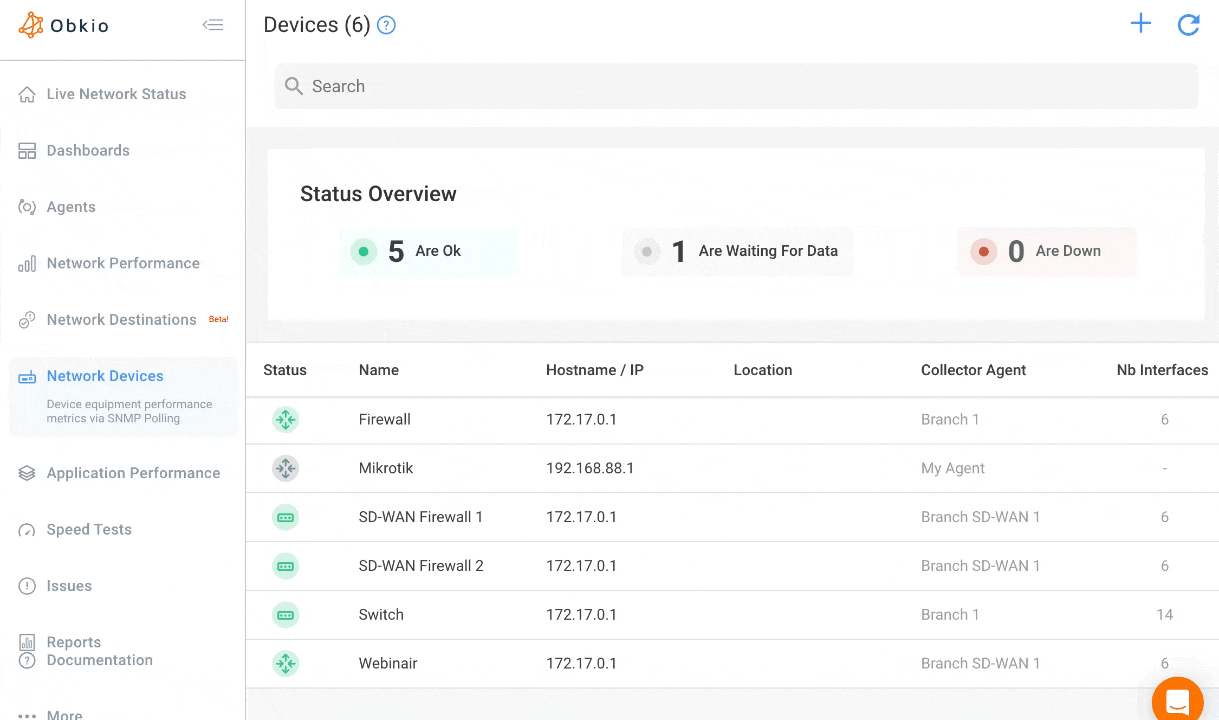

When measuring bandwidth, it's important to differentiate between upload and download bandwidth as they represent different aspects of data transfer in a network.
Upload bandwidth refers to the speed at which data can be sent from a device to a destination or server on the network or the Internet. It represents the capacity for transmitting data from the user's device, such as uploading files, sending emails, or making video calls. For example, when you attach a file to an email and hit send, the upload bandwidth determines how quickly the file is sent from your device to the email server.
Download bandwidth, on the other hand, refers to the speed at which data can be received by a device from a source or server on the network or the Internet. It represents the capacity for retrieving data from remote servers or sources. Download bandwidth affects activities such as browsing the web, streaming videos or music, and downloading files. When you visit a website or stream a video, the download bandwidth determines how quickly the content is fetched from the server and displayed on your device.
It's important to note that upload and download bandwidths can have different speeds. In many cases, internet service providers (ISPs) offer asymmetrical bandwidth, meaning the upload and download speeds may not be the same. This is because typical Internet usage involves more downloading (e.g., browsing, streaming) than uploading (e.g., sending emails, uploading files). As a result, ISPs often allocate higher download bandwidth to cater to the majority of users' needs.
When measuring bandwidth, it's recommended to measure both upload and download speeds to gain a comprehensive understanding of your network's performance capabilities. This information can help you identify any discrepancies, optimize your network resources, and ensure an optimal user experience for both uploading and downloading data.
Learn about the differences between network speed, bandwidth & throughput. Find out why your business should measure them and how!
Learn more

In the realm of network management, the ability to accurately measure bandwidth is a game-changer. Embracing a Network Performance Monitoring tool opens doors to a host of advantages that go beyond mere bandwidth assessment.
Using a Network Performance Monitoring tool and Bandwidth Monitoring tool in one to measure bandwidth offers a plethora of benefits that elevate network management to a new level of efficiency and effectiveness. With real-time insights into bandwidth utilization, network administrators can identify potential bottlenecks, optimize resource allocation, and plan for future growth with unparalleled precision.
Moreover, monitoring latency, packet loss, and other critical metrics alongside bandwidth empowers proactive troubleshooting and swift issue resolution. In essence, harnessing the power of a Network Performance Monitoring tool not only ensures seamless connectivity but also maximizes network performance, paving the way for an agile, resilient, and future-ready network infrastructure.
In your quest for an effortless way to monitor network performance and measure bandwidth, Obkio's Network Performance Monitoring tool is the ultimate solution.

This synthetic, end-to-end platform revolutionizes the way you assess, analyze, and optimize your network bandwidth. Using synthetic traffic to perform synthetic testing and simulate real-world network behaviour and user experiences, Obkio precisely measures network bandwidth and other critical metrics.
Deploying Network Monitoring Agents at different ends of your network, Obkio continuously exchanges synthetic traffic to provide accurate measurements without external interference, ensuring a seamless user experience. Say hello to effortless and precise bandwidth measurements with Obkio's Network Performance Monitoring tool.

Obkio measures bandwidth and end-to-end network performance and uses continuous synthetic traffic from Network Monitoring Agents deployed in key network locations like offices, data centers and clouds.
For your end-to-end bandwidth monitoring setup, you’ll need the following Monitoring Agents (which Obkio’s Onboarding Wizard with help you deploy):
- Local Agents: Installed in the targeted office location where you want to measure bandwidth and network performance. There are several Agent types available (all with the same features), and they can be installed on MacOS, Windows, Linux and more.
- Public Monitoring Agent: These are deployed over the Internet and managed by Obkio. They compare performance up to the Internet and quickly identify if the problem is global or specific to the destination. For example, measure bandwidth between your branch office and Google Cloud.
The Agents measure bandwidth in your network by sending and monitoring synthetic traffic through your network every 500ms using for the most precise network throughput measurements.
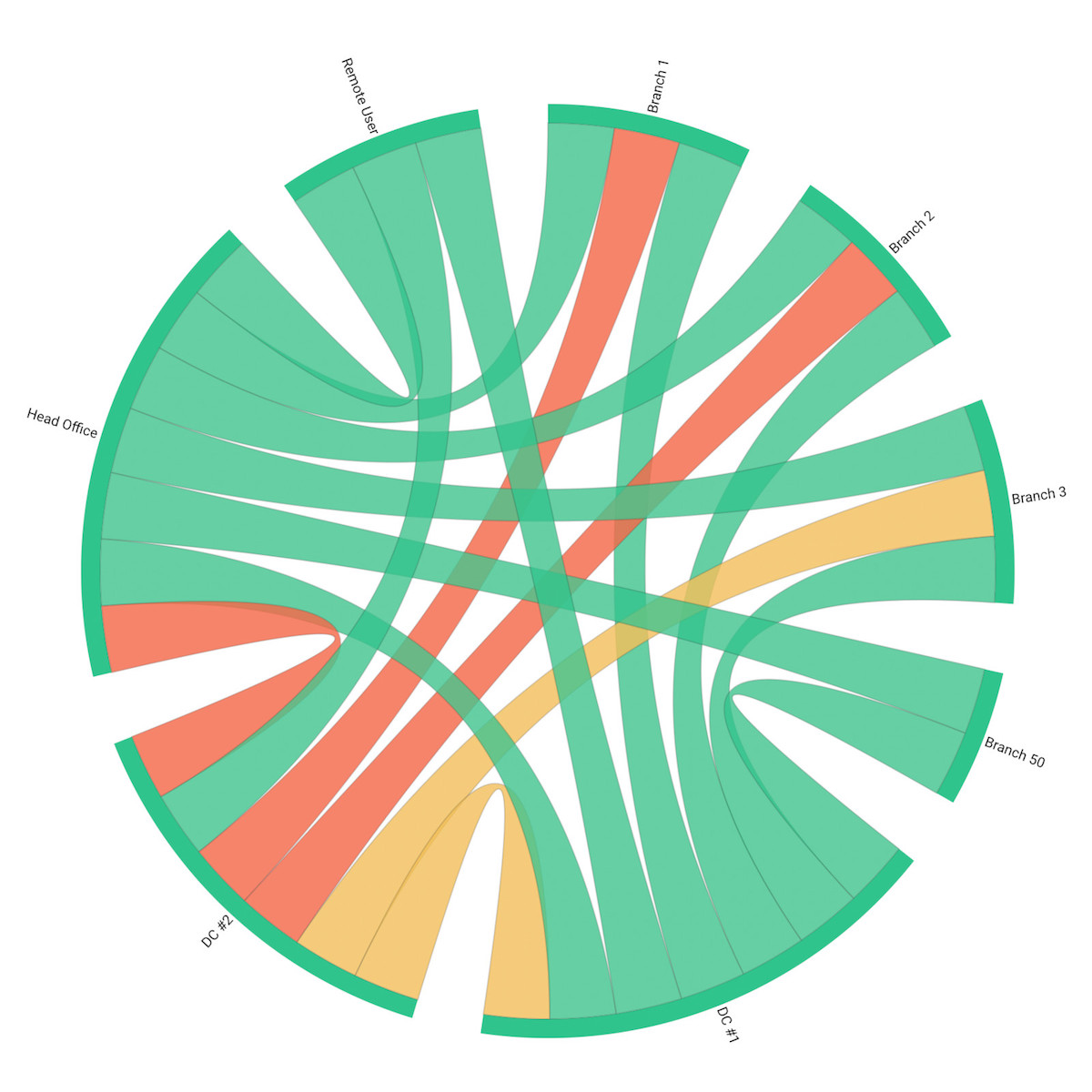
Network devices and equipment are prone to problems like high CPU usage and high bandwidth usage - which is why Network Device Monitoring plays a crucial role in accurately measuring bandwidth within a network.
So when you’re looking to measure bandwidth with Obkio, make sure to activate Network Device Monitoring.
Network device monitoring allows for direct and real-time access to data from routers, switches, and other network devices. This ensures that the measured bandwidth reflects the actual traffic flow and utilization within the network, providing accurate insights into how much data is being transmitted and received.
Network device monitoring provides real-time updates on bandwidth utilization and allows network admins to proactively identify network bottlenecks causing bandwidth constraints.
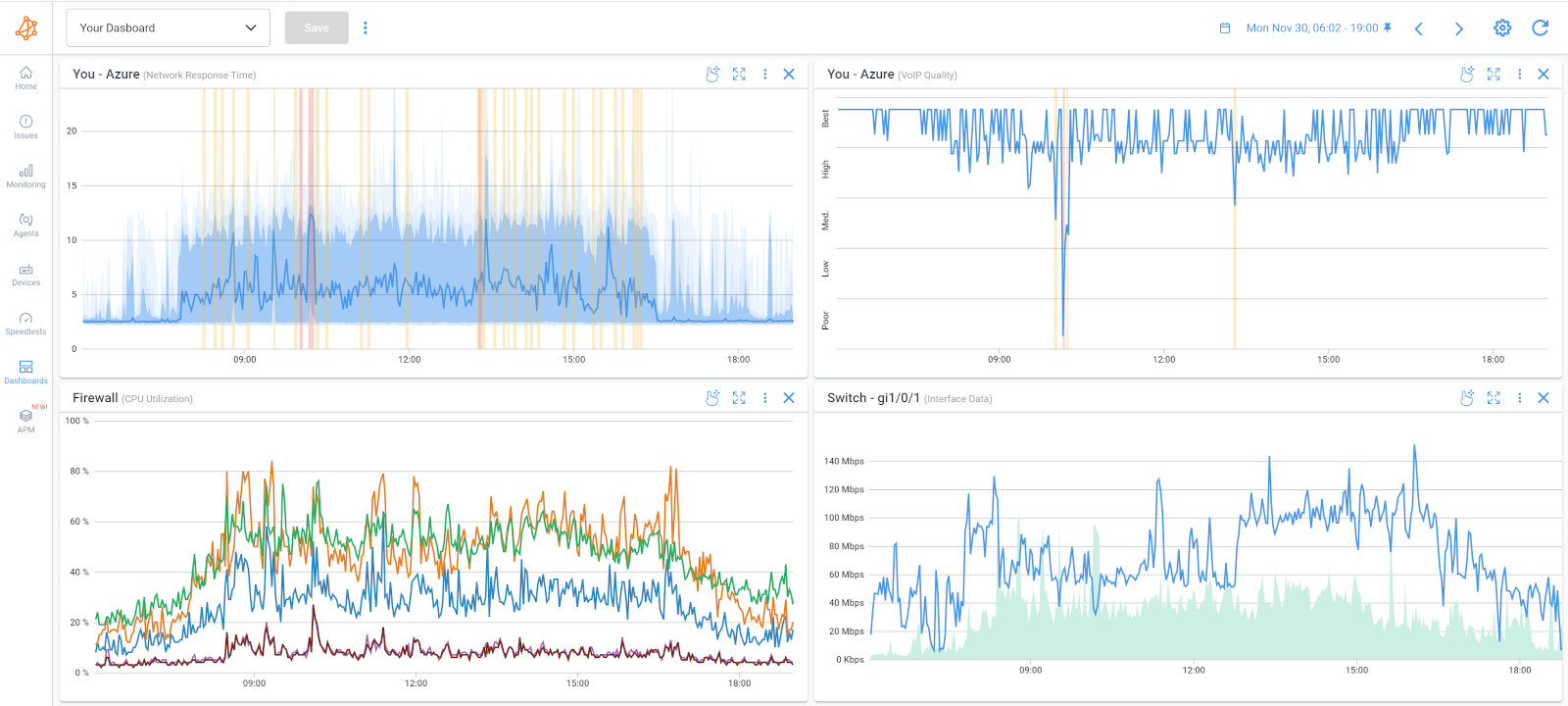
When measuring bandwidth, it is essential to monitor specific network devices that play a significant role in data transmission and traffic management, like:
- Routers: Routers are critical devices that direct traffic between different networks or subnets. They determine the best path for data packets to reach their destinations. Monitoring routers allows administrators to track bandwidth utilization on different interfaces and identify any congestion points.
- Switches: Network Switches are responsible for connecting devices within a local network and forwarding data to the intended recipient. Monitoring network switches helps users understand local network traffic patterns and identify bandwidth consumption at the port level.
- Firewalls: Firewalls provide security by filtering and controlling network traffic based on defined rules. Monitoring firewall devices helps in understanding the impact of security policies on bandwidth usage and identifying any bandwidth-related security issues.
- Load Balancers: Load balancers distribute network traffic across multiple servers to optimize performance and prevent network overload. Monitoring load balancers enables administrators to ensure even distribution of traffic and identify potential performance bottlenecks.
- Access Points (APs): Access points are used in wireless networks to provide connectivity for wireless devices. Monitoring APs helps in tracking wireless network usage and ensuring optimal bandwidth allocation for wireless clients.
- Network Probes and Packet Analyzers: Network probes and packet analyzers (e.g., Wireshark) are used to capture and analyze network traffic. They provide detailed insights into the types of traffic and bandwidth utilization on the network.
- Network Gateways: Network gateways connect different networks, such as LANs and WANs. Monitoring gateways is important for understanding bandwidth usage between different network segments and optimizing inter-network data flow.
- WAN Accelerators: WAN accelerators optimize data transmission between geographically dispersed locations. Monitoring WAN accelerators helps in gauging their impact on bandwidth utilization and network performance.
Once your Monitoring Agents are deployed and your network devices are configured, Obkio's Network Performance Monitoring tool continuously measures bandwidth using a synthetic, end-to-end approach.
Obkio generates synthetic traffic, which simulates real data packets, to measure bandwidth. This synthetic traffic is sent between Monitoring Agents deployed at different endpoints of the network.
- Continuous Traffic Exchange: The Monitoring Agents continuously exchange synthetic traffic to measure the actual bandwidth between these endpoints. This process allows for consistent and real-time monitoring of bandwidth performance.
- End-to-End Measurements: By measuring bandwidth end-to-end (from one monitoring agent to another), Obkio captures the true network behaviour experienced by users. This approach eliminates the need to rely on external factors or user activity for measurements, providing a more controlled and accurate assessment of bandwidth.
- Data Collection and Analysis: As the synthetic traffic flows between the monitoring agents, Obkio collects and analyzes performance data. The tool records metrics such as throughput, latency, and packet loss, providing comprehensive insights into the network's behaviour and performance.
- Real-Time Reporting: Obkio's Network Performance Monitoring tool offers real-time reporting and visualization of the measured bandwidth. Network administrators can access easy-to-understand dashboards and charts that display the bandwidth utilization and performance metrics across different network segments.
- Ongoing Monitoring: The continuous exchange of synthetic traffic ensures ongoing monitoring of bandwidth performance. This allows network administrators to identify trends, spot anomalies, and proactively address any bandwidth-related issues before they impact user experience.
By using synthetic traffic and end-to-end measurements, Obkio eliminates external variables that could affect bandwidth measurements. This approach ensures that the measured bandwidth is representative of the network's capabilities and offers valuable insights for optimizing network performance and resource allocation.
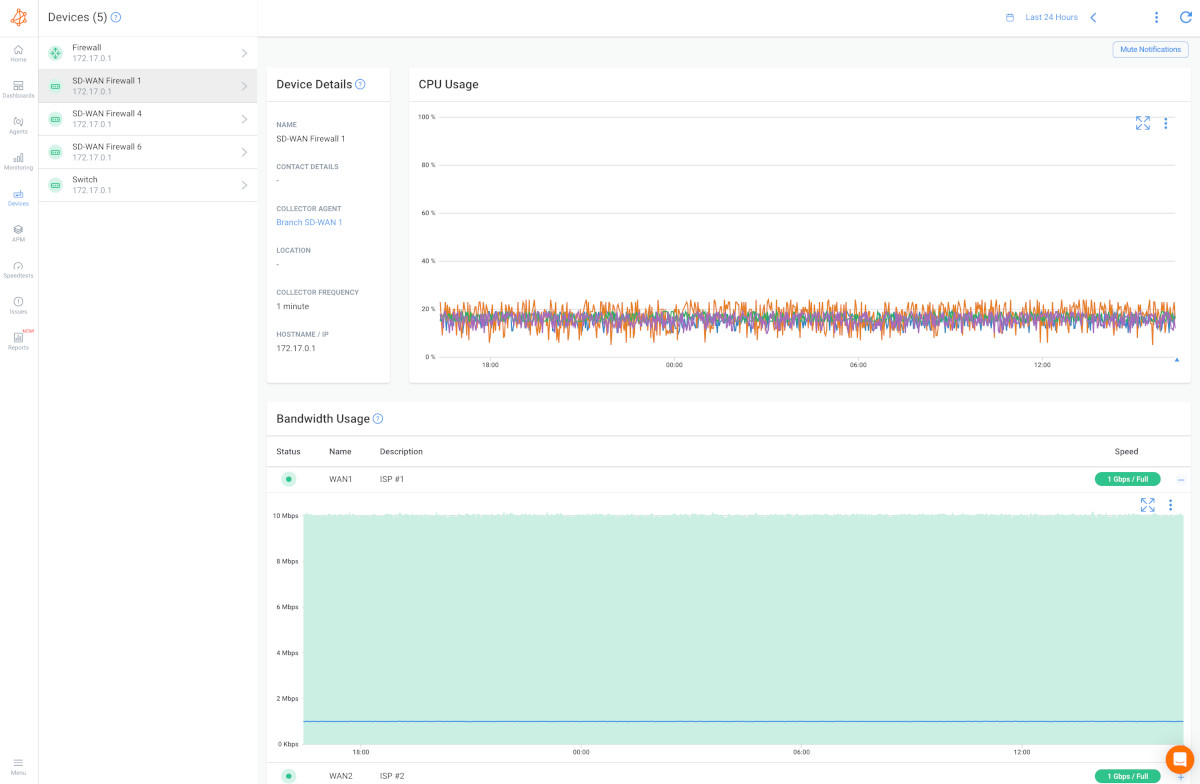

When measuring bandwidth, it is essential to consider other network metrics that complement the understanding of overall network performance. These metrics provide valuable insights into various aspects of the network and help identify potential issues affecting bandwidth.
Lucky for you, Obkio measures a variety of other network metrics that impact bandwidth and are essential to end-to-end network performance Here are some key network metrics to measure alongside bandwidth:
- Latency: Latency measures the delay or time it takes for data packets to travel from the source to the destination. High latency can cause delays in data transmission, affecting the responsiveness of applications and user experience.
- Packet Loss: Packet loss refers to the percentage of data packets that fail to reach their destination. It can be caused by network congestion or faulty network devices, leading to retransmissions and decreased data throughput.
- Jitter: Jitter measures the variation in the delay of data packet delivery. High jitter can cause disruptions in real-time applications like VoIP or video conferencing, leading to choppy audio or video. This is especially true of VoIP jitter
- Round-Trip Time (RTT): RTT measures the time it takes for a data packet to travel from the source to the destination and back again. It is an important metric for assessing network performance in applications like online gaming or video conferencing.
- Network Utilization: Network utilization measures the percentage of available bandwidth being used at a specific time. It helps in understanding how efficiently the network is handling traffic and whether there is potential for congestion.
- Throughput: While bandwidth measures the maximum data transfer rate, throughput represents the actual data transfer rate observed in a network. It takes into account factors like latency and packet loss, providing a more realistic picture of data transmission efficiency.
- Retransmission Rate: The retransmission rate indicates the frequency of data packets that need to be resent due to errors or packet loss. A high retransmission rate can indicate network issues affecting data reliability.
- Network Error Rate: The network error rate measures the percentage of data packets that contain errors or need to be retransmitted. A high error rate may indicate problems with network devices or signal interference.
- Network Response Time: Network response time measures the time taken for a device or application to respond to a request. It is crucial for assessing user experience and application performance.
By measuring these additional network metrics alongside bandwidth, administrators can gain a comprehensive view of network health, identify performance bottlenecks, and troubleshoot network issues more effectively. These metrics help ensure a robust and optimized network infrastructure, enhancing user satisfaction and productivity.
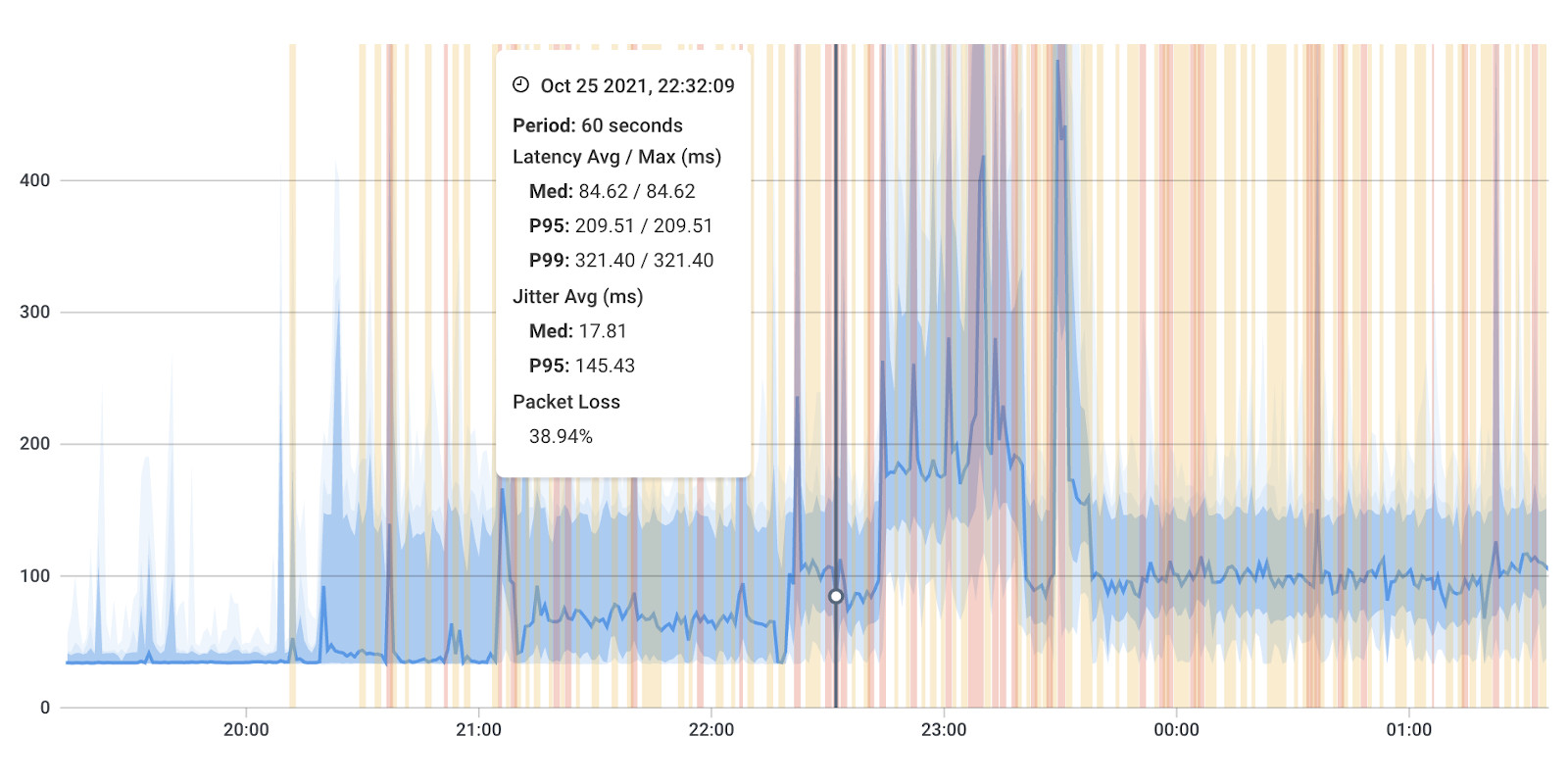
When it comes to measuring bandwidth, having the right tools at your disposal can make all the difference. In this section, we explore a range of powerful techniques designed to provide precise and insightful bandwidth measurements.
In this article, we showed you how to measure bandwidth and bandwidth utilization using Network Performance Monitoring tools - that’s because they give you the most complete view of your network performance, and can act as a monitoring and troubleshooting tool simultaneously. But depending on the needs of your network, there are some other tools and techniques available.
Network Performance Monitoring Software, like Obkio, is a comprehensive and versatile solution designed to continuously monitor and analyze various aspects of network performance, including bandwidth utilization. This software offers a centralized platform for network administrators to gain real-time insights, historical data, and detailed statistics on the network's health and traffic patterns.
Here are some key features and benefits of using Network Performance Monitoring Software for measuring bandwidth:
- Real-time monitoring for immediate insights.
- Comprehensive metrics beyond bandwidth, including latency and packet loss.
- Historical data analysis for trend identification and capacity planning.
- Customizable alarms and alerts for quick issue detection.
- User-friendly dashboards for easy visualization of data.
- Supports a wide range of network devices.
- Provides historical reporting for presentations and audits.
- Facilitates network troubleshooting for faster issue resolution.
Online speedtest websites, like Ookla's Speedtest.net or Fast.com, offer a simple and quick way to measure the upload and download speeds of an internet connection. These platforms use servers located worldwide to initiate data transfers and calculate the speed based on the time it takes for data to travel. While speedtest websites offer instant results and convenience, they may not provide the most comprehensive measurement of bandwidth performance. For more in-depth and precise assessments, using additional techniques such as network testing tools or Network Performance Monitoring Software may be necessary.
Network testing tools are specialized software applications designed to measure and assess network performance, including bandwidth utilization, within a local network environment. Network testing offers more in-depth and customizable measurements compared to speed test websites. They create synthetic network traffic between devices, providing detailed metrics and network statistics on throughput, latency, and packet loss.
Command-line tools like iperf, wget, or curl can be used to perform bandwidth measurements. Command-line utilities for measuring bandwidth work by generating synthetic traffic between the source and destination endpoints and measuring the time it takes for data to be transmitted. They calculate the data transfer rate (throughput) based on the amount of data transferred and the time taken.
These utilities provide a hands-on and customizable approach to bandwidth measurement, offering detailed performance metrics such as throughput, latency, and packet loss. However, they require users to be familiar with command-line interfaces and networking concepts.
Using Simple Network Management Protocol (SNMP) for measuring bandwidth allows network administrators to efficiently monitor network devices and collect performance data. SNMP allows network administrators to monitor network devices and collect bandwidth-related information, among other performance metrics. SNMP-enabled devices, such as routers and switches, can be queried for bandwidth statistics.
SNMP operates in a client-server model, with network devices (agents) providing standardized data through Management Information Base (MIB) variables. SNMP managers can poll agents for bandwidth utilization, set threshold alerts, and integrate SNMP-enabled devices into network management systems. This standardized and extensible approach simplifies network monitoring and facilitates interoperability across different vendors' devices.
Some Network Performance Monitoring tools, like Obkio, offer SNMP monitoring features as part of their network monitoring solution.
Packet capture tools can be used to analyze network traffic and calculate bandwidth utilization based on captured packets. Using packet capture and analysis for measuring bandwidth involves capturing and analyzing network traffic data to gain detailed insights into bandwidth utilization and network performance. It provides a real-world view of data flows, helping identify top talkers, analyze protocols, calculate throughput and latency, troubleshoot issues, and enhance security.
While powerful, careful filtering and analysis are needed due to the large volume of captured data. Packet capture is valuable for a precise and in-depth understanding of network behaviour and optimization.
Using Internet Control Message Protocol (ICMP) tests for measuring bandwidth involves using ICMP packets to assess network responsiveness and approximate network latency. ICMP is a protocol primarily used for diagnostic and control purposes in IP networks. ICMP tests are commonly performed using tools like ping and traceroute.
- ICMP tests, like ping, assess network latency by measuring Round-Trip Time (RTT).
- Lower RTT values indicate lower latency and faster network response times.
- ICMP tests can detect packet loss, indicating potential network issues.
- Traceroute, an ICMP-based test, helps identify the number of hops and potential bottlenecks in the network.
- ICMP tests are simple, widely supported, and easily accessible on most devices.
ICMP tests are suitable for obtaining a basic assessment of network latency and detecting potential packet loss. While they provide a quick and straightforward method for latency estimation, they do not directly measure bandwidth and have limitations regarding interference from network security measures.
Network emulators are powerful tools that simulate real-world network conditions to test applications and services under different bandwidth scenarios. They allow for realistic testing, capacity planning, and application optimization.
One of the primary functions of network emulators is to limit the available bandwidth during testing. By setting bandwidth constraints, administrators can gauge how applications and services respond to limited network resources.
Emulators provide end-to-end testing, network load testing, and the ability to replicate network challenges in a risk-free environment. They are valuable for evaluating vendor devices and ensuring a reliable and efficient network infrastructure.
When selecting a technique for measuring bandwidth, consider factors such as the scope of measurement (local or internet-based), the level of accuracy required, and whether real-time monitoring or point-in-time testing is needed. Each technique has its pros and cons, so using a combination of methods may provide a more comprehensive understanding of the network's bandwidth performance.
In the realm of network performance monitoring and bandwidth measurement, two primary approaches stand out: Active and Passive Bandwidth Measurement. Each method offers distinct advantages, allowing network administrators to gain valuable insights into their network's performance. Active vs. Passive network monitoring methods are also used in the tools we mentioned in the previous section, so understanding them is important for choosing the right tool for your business.
In this section, we'll explore the key differences and benefits of active and passive bandwidth measurement, helping you choose the right approach to suit your specific monitoring needs.
Active Bandwidth Measurement is a proactive approach used to assess network performance and bandwidth utilization. In this method, synthetic traffic is generated and sent over the network for testing purposes. Some Network Performance Monitoring tools, like Obkio, use this active monitoring approach for performance monitoring.
By precisely controlling the testing environment and customizing parameters, administrators can monitor real-time performance, stress test the network, and troubleshoot potential issues
- Synthetic Traffic Generation: Active bandwidth measurement involves generating synthetic traffic and sending it over the network for testing purposes. The synthetic traffic is typically generated using tools like network testing software or command-line utilities.
- Controlled Testing Environment: Active measurements allow administrators to control the testing environment and precisely define the type, amount, and timing of the traffic sent over the network.
- Customizable Parameters: Administrators can customize the test parameters, including data packet size, test duration, number of connections, and target endpoints.
- Real-Time Monitoring: Active measurements provide real-time monitoring of bandwidth utilization and performance metrics during the test.
- Continuous Monitoring: Active measurements can be scheduled at regular intervals for continuous monitoring and trend analysis over time.
- Network Stress Testing: Active measurements are useful for stress testing the network to assess its performance under heavy traffic loads and identify potential bottlenecks.
- Quick Troubleshooting: Active measurements can help quickly identify performance issues and bandwidth constraints in the network.
- Impact on Network: Active measurements introduce some level of additional traffic into the network, which may impact the actual user experience during testing.
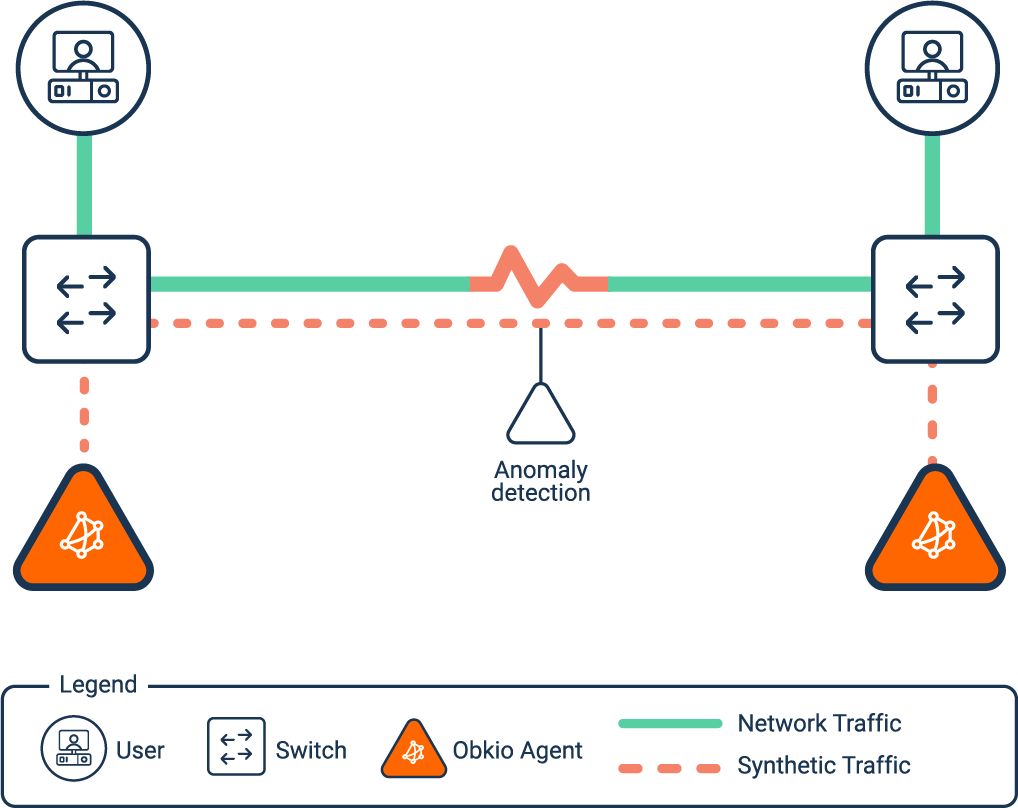
Passive Bandwidth Measurement offers a non-intrusive approach to evaluate network performance and bandwidth utilization. Unlike active methods that generate synthetic traffic, passive measurement involves observing the existing network traffic without introducing additional load. Through the analysis of captured data, administrators can gain insights into real user behaviour, historical trends, and potential anomalies in network traffic.
- Observing Existing Traffic: Passive bandwidth measurement involves observing the existing network traffic without introducing any synthetic traffic or generating additional load.
- Non-Intrusive: Passive measurements are non-intrusive and do not interfere with the normal network operations or user experience.
- Network Traffic Analysis: Passive measurement tools analyze the captured traffic data to extract bandwidth utilization and other performance metrics.
- Insights into Real User Behaviour: Since passive measurement analyzes actual user traffic, it provides insights into real user behaviour and application usage.
- No Control Over Traffic: Unlike active measurements, passive measurements do not allow administrators to control the traffic being analyzed. They can only observe the existing traffic.
- Historical Analysis: Passive measurements often store historical traffic data, allowing for retrospective analysis and long-term trend monitoring.
- Detecting Anomalies: Passive measurements can help identify unusual patterns or anomalies in network traffic that may indicate potential issues.
- Requires Specialized Tools: Passive bandwidth measurement requires specialized packet capture and analysis tools to capture and interpret network traffic.
The choice between active and passive bandwidth measurement depends on the specific use case and requirements.
Active bandwidth monitoring is ideal for controlled testing, stress testing, and quick troubleshooting, but it introduces additional traffic to the network. Although, with the right active monitoring tool, this traffic is usually light and non-intrusive.
Passive bandwidth monitoring, on the other hand, provides non-intrusive insights into real user behaviour and long-term trend monitoring.
Administrators may use a combination of both methods to gain a comprehensive understanding of their network's performance.
Discover the differences, benefits, and implementation strategies of active network monitoring vs passive network monitoring.
Learn more

Interpreting bandwidth measurements is essential for understanding the performance of a network. Good bandwidth measurements indicate a robust and responsive network, ensuring smooth data transfer and an excellent user experience. On the other hand, bad bandwidth measurements can point to potential issues, such as network congestion, slow data transfer, and disruptions.
Good bandwidth measurements indicate ample network capacity, allowing for fast data transfer and smooth user experiences.
- Low Latency: Low latency, measured in milliseconds, indicates good latency and leads to fast data packet delivery, resulting in responsive network performance.
- Low Packet Loss: Good bandwidth measurements exhibit minimal packet loss, ensuring data packets reach their destination reliably.
- Consistent Performance: A well-performing network maintains consistent throughput and low jitter, providing a stable user experience.
- Adequate QoS: Bandwidth measurements align with Quality of Service (QoS) policies, prioritizing critical applications and ensuring their optimal performance.
Low bandwidth measurements indicate limited network capacity, leading to slow data transfer and potential congestion during peak usage.
- High Latency: High latency measurements result in noticeable delays, affecting real-time applications and user interactions.
- High Packet Loss: Bad bandwidth measurements with high packet loss indicate data integrity issues and disruptions in data delivery.
- Inconsistent Performance: Unstable throughput and high jitter can lead to unpredictable network performance and poor user experiences.
- Insufficient QoS: Bandwidth measurements conflict with QoS requirements, resulting in critical applications competing for limited resources.
It's important to note that what is considered good or bad bandwidth measurements may vary based on the network's purpose and intended usage.
For example: A residential internet connection with a few Mbps might be suitable for casual browsing but inadequate for hosting multiple video conferencing sessions simultaneously.
Businesses, especially those dealing with real-time applications or data-intensive tasks, typically strive for high-performance networks that meet their specific requirements.
Network administrators regularly monitor bandwidth measurements to ensure they align with the desired performance levels and make necessary adjustments to optimize the network's performance.
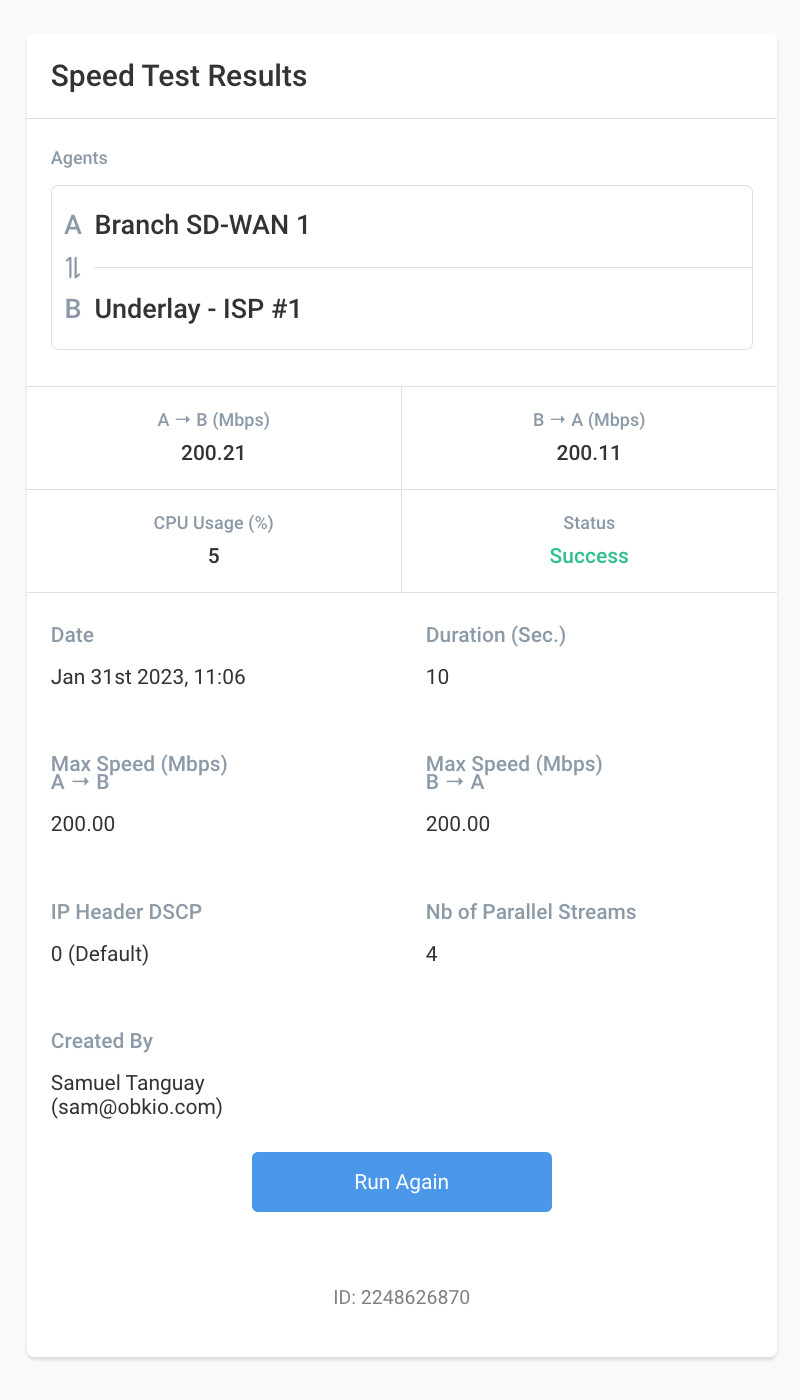

Before we delve into the exciting world of measuring bandwidth, it's essential to consider a few factors that can influence the accuracy and reliability of our results. Understanding these considerations will empower us to conduct more informed and precise measurements.
So, let's take a moment to explore some crucial elements that can impact bandwidth measurements and ensure we're well-equipped for the journey ahead.
- Network Congestion: Bandwidth measurements can be impacted by network congestion, which occurs when there is high traffic or data demand on the network. During peak usage times, such as busy office hours or evenings when many users are streaming content, network congestion can lead to reduced bandwidth availability and slower data transfer speeds.
- Network Type: The type of network connection being used can affect bandwidth measurements. Wired Ethernet connections typically offer more stable and consistent bandwidth compared to wireless connections like Wi-Fi or cellular networks, which can be more susceptible to interference and signal fluctuations.
- Hardware Limitations: The capabilities of network devices, such as routers, switches, and network interface cards, can influence bandwidth measurements. Outdated or low-performance hardware may not be able to handle high-speed data transfers, leading to lower measured bandwidth.
- Network Configuration: Network configurations, such as Quality of Service (QoS) settings, traffic shaping, or bandwidth throttling, can impact bandwidth measurements. These configurations prioritize certain types of traffic or limit bandwidth for specific applications, potentially affecting the measured speeds.
- Internet Service Provider (ISP) Restrictions: Some ISPs may impose bandwidth caps or limit the maximum bandwidth available to users, which can affect the results of bandwidth measurements. It's essential to consider any such restrictions imposed by the ISP when interpreting the results.
- Time of Day: Network usage patterns can vary throughout the day. Bandwidth measurements performed during off-peak hours may yield different results than those conducted during peak hours when network traffic is higher.
- Protocol Overhead: The protocol overhead, such as TCP/IP, can affect bandwidth measurements. Some data is used for control and error-checking purposes, reducing the actual data transfer rate.
- Data Compression: Compression techniques used by applications or network monitoring protocols can impact bandwidth measurements. Data that is already compressed before transmission may appear to have a lower bandwidth requirement.
- Shared Resources: In shared network environments, multiple devices or users may be competing for the same bandwidth, leading to variations in measured speeds depending on the level of activity on the network.
- Distance and Routing: For network connections over long distances, the physical distance between endpoints and the routing taken by data packets can affect latency and bandwidth measurements.
When conducting bandwidth measurements, it's essential to consider these factors and perform multiple tests under different conditions to obtain a more accurate and comprehensive understanding of the network's bandwidth capabilities.


As we dive into the realm of measuring bandwidth in this article, we know some of you can't help but wonder, why should businesses care about it in the first place. Sure, bandwidth might sound like something techies obsess over, but it holds the key to unlocking optimal network performance.
Measuring bandwidth in a business network is essential for several reasons that directly impact the organization's efficiency, productivity, and cost-effectiveness. Let’s dive into them in more detail:
- Optimizing Network Performance: Bandwidth measurement allows businesses to identify network bottlenecks, congestion points, and areas of inefficiency. By understanding how bandwidth is utilized, they can optimize network performance and configurations to ensure smooth operations and faster data transfers.
- Managing User Experience: Bandwidth directly affects the user experience. Measuring bandwidth helps ensure that employees and customers have a seamless experience when using applications, accessing cloud services, streaming media, or engaging in online interactions.
- Capacity Planning: By monitoring bandwidth usage, businesses can accurately assess their current and future network requirements. Capacity planning helps avoid unexpected network slowdowns, network outages, or performance issues due to insufficient bandwidth.
- Cost Management: Bandwidth measurement assists in determining the appropriate network service plans and resources needed to meet the organization's requirements. It helps avoid overprovisioning, reducing unnecessary expenses on excessive bandwidth.
- Prioritizing Critical Applications: In situations where bandwidth resources are limited, businesses can prioritize critical applications and services, ensuring that mission-critical tasks receive sufficient network resources.
- Identifying Security Threats: Bandwidth measurement can help identify unusual or suspicious traffic patterns, which may indicate security threats such as Distributed Denial of Service (DDoS) attacks or unauthorized data exfiltration.
- Troubleshooting Performance Issues: When network performance issues arise, bandwidth measurement serves as a valuable diagnostic tool. It helps network administrators pinpoint the source of the problem and take appropriate actions to resolve the issue quickly.
- Vendor Evaluation: For businesses using third-party network services or cloud providers, bandwidth measurement allows them to evaluate whether service-level agreements (SLAs) are being met, ensuring that vendors deliver the promised bandwidth and performance.
- Capacity Management for Remote Workers: With the increasing trend of remote work, businesses need to ensure that their network infrastructure can support the bandwidth requirements of remote employees for smooth collaboration and access to company resources.
- Supporting Digital Transformation: As businesses adopt new technologies and cloud-based solutions, measuring bandwidth becomes critical for ensuring a successful digital transformation. It enables the organization to meet the demands of modern applications and services.
In conclusion, bandwidth measurement is a fundamental practice for businesses to effectively monitor their network infrastructure, deliver an optimal user experience, allocate resources efficiently, and adapt to evolving technological demands. By understanding and optimizing bandwidth utilization, businesses can ensure a stable, secure, and high-performing network environment conducive to growth and success.
One of the primary reasons for measuring bandwidth in a network is its profound impact on overall network performance. Bandwidth directly influences data transfer rates, network responsiveness, and user experiences.
In this section, we explore the importance of bandwidth measurement and how understanding network bandwidth helps optimize performance, ensure seamless user interactions, and enhance the efficiency of various applications and services.
- Data Transfer Rate: Bandwidth determines the maximum data transfer rate, which is the amount of data that can be transmitted per unit of time. Higher bandwidth allows for faster data transmission, resulting in quicker file transfers, website loading times, and application response.
- Latency and Responsiveness: Inversely related to bandwidth, latency is the time it takes for data to travel from the source to the destination. Lower bandwidth often leads to higher latency, causing delays in data delivery and reduced network responsiveness.
- Multi-User Experience: In environments with multiple users or devices sharing the same bandwidth, network performance can suffer during peak hours. Insufficient bandwidth may lead to slowdowns, buffering, and poor user experiences.
- Video and Audio Streaming: High-bandwidth connections are crucial for smooth video and audio streaming. Inadequate bandwidth can result in buffering, pixelation, or dropped frames during streaming sessions.
- Cloud Applications and Services: Cloud-based applications and services rely on sufficient bandwidth to provide optimal performance. Inadequate bandwidth can lead to slow cloud application response times and reduced productivity.
- File Transfers: Larger files, such as those in video editing or data backups, require more bandwidth to transfer quickly. Limited bandwidth can significantly extend the time needed to complete file transfers.
- Virtual Meetings and Video Conferencing: Bandwidth plays a crucial role in virtual meetings and video conferencing. Sufficient bandwidth ensures smooth video and audio quality, while low bandwidth can cause pixelated video and audio dropouts.
- Online Gaming: Online gaming requires low latency and a stable connection. Sufficient bandwidth ensures a seamless gaming experience, reducing lags and delays during gameplay.
- Data Backup and Recovery: Inadequate bandwidth can hinder data backup and recovery processes, leading to longer backup times and slower data restoration.
- Overall Network Efficiency: Bandwidth limitations can lead to network congestion and network bottlenecks, affecting the overall efficiency and productivity of the network.
In summary, network bandwidth directly impacts data transfer rates, network responsiveness, and the overall user experience. Adequate bandwidth is crucial for ensuring smooth operations, especially in today's digital world, where applications, services, and data are heavily reliant on efficient network performance.
Measuring bandwidth can uncover various potential issues that may affect network performance and user experience. Some of the common bandwidth-related issues include:
- Network Congestion: Bandwidth measurements can reveal periods of high network utilization, indicating network congestion (WAN or LAN congestion). Network congestion leads to slow data transfer and delays in accessing applications and services.
- Insufficient Bandwidth: Low bandwidth measurements may indicate that the network lacks the necessary capacity to handle the current data traffic demands, resulting in reduced data transfer speeds and responsiveness.
- Bottlenecks: Bandwidth measurements can pinpoint specific network segments or devices that act as network bottlenecks, limiting data flow and causing performance issues.
- Overloaded Links: Identifying links with consistently high bandwidth usage can help administrators identify which areas of the network need additional capacity or optimization.
- Inconsistent Performance: Spikes or fluctuations in bandwidth measurements can indicate inconsistent network performance, leading to varying user experiences and application performance.
- Content Delivery Issues: Bandwidth measurements may uncover problems with content delivery, where certain data or media files take longer to load due to limited bandwidth.
- Real-Time Application Problems: High bandwidth utilization during real-time applications (e.g., video conferencing or VoIP) may result in packet loss or high latency, affecting the quality of communication.
- Network Security Concerns: Unexpected bandwidth usage patterns might indicate unauthorized network access or potential security breaches.
- Misconfigured QoS Policies: Incorrectly configured Quality of Service (QoS) policies can lead to inadequate bandwidth allocation for critical applications, negatively impacting their performance.
- Network Performance Degradation Over Time: Historical bandwidth measurements can reveal performance degradation trends, helping identify long-term issues or changes in network behaviour.
By regularly measuring bandwidth and analyzing the results, network administrators can detect and address these potential issues promptly, ensuring a more reliable and efficient network environment. Proactive monitoring and troubleshooting based on bandwidth measurements help maintain optimal network performance and deliver a seamless user experience.

Accurate bandwidth measurement is essential for gaining reliable insights into network performance and making informed decisions. Regardless of the technique or tool you opt for to measure bandwidth, there are essential factors to consider to ensure accurate and meaningful results.
Some of these points are things we’ve already touched on in this article, but it’s always best to have them summarized!
- Selecting the Right Bandwidth Measurement Tool: Choose a reputable and appropriate bandwidth measurement tool that aligns with your network infrastructure and requirements. Consider factors like supported protocols, accuracy, and compatibility with your network devices.
- Isolate Testing from Production: When conducting bandwidth tests, ensure that the testing environment is isolated from the production network to prevent interference and disruptions for end-users.
- Multiple Bandwidth Testing Points: Perform bandwidth tests from multiple test points across the network to gain a comprehensive understanding of performance from different locations and segments.
- Off-Peak Testing: Schedule bandwidth tests during off-peak hours to avoid additional traffic that might affect the accuracy of measurements.
- Test Frequency: Regularly schedule bandwidth tests to track changes in network performance over time. Frequent testing helps identify trends and potential issues before they become critical.
- Test at Different Times: Besides off-peak hours, conduct tests during various times of the day to capture network performance under different usage scenarios.
- Account for Bursty Traffic: Some network applications generate bursty traffic (packet bursts). Ensure that your bandwidth measurement tool can capture these fluctuations accurately.
- Capture Both Upload and Download Bandwidth: Measure both upload and download bandwidth separately, as they can have different performance characteristics.
- Eliminate External Factors: During bandwidth tests, eliminate or minimize external factors that could influence results, such as other running applications, background downloads, or unrelated network traffic.
- Check for Congestion Points: Identify potential congestion points by analyzing bandwidth utilization at different network devices and interfaces.
- Monitor for Network Anomalies: Set up network monitoring alerts for unusual bandwidth spikes or drops, as these could indicate network issues or security threats.
- Consider Real-User Experience: Combine bandwidth measurement with real-user monitoring to understand how actual users experience network performance.
- Validation with Other Metrics: Cross-validation bandwidth measurements with other network performance metrics like latency, jitter, and packet loss for a comprehensive assessment.
- Document and Analyze Results: Maintain a log of bandwidth measurement results, and analyze the data regularly to track improvements or detect deteriorations in network performance.
- Review Network Capacity Planning: Use bandwidth measurements to inform network capacity planning and ensure that future network upgrades meet the organization's growing demands.
By following these best practices, businesses can achieve accurate and reliable bandwidth measurements, which serve as the foundation for effective network optimization, troubleshooting, and decision-making. A well-monitored and optimized network not only enhances user experiences but also boosts productivity and ultimately contributes to the overall success of the business.
Interpreting bandwidth measurement results is a crucial step in understanding network performance and making informed decisions. However, the data obtained from bandwidth tests can be complex and may require careful analysis to draw meaningful conclusions. Here's an expanded explanation of how to interpret bandwidth measurement results effectively:
The most basic interpretation of bandwidth measurements is bandwidth utilization, which we explain at the beginning of the article. It is the percentage of the available bandwidth that is actively being used.
A high bandwidth utilization rate is a clear indication that the network is operating near its maximum capacity, meaning that a significant portion of the available bandwidth is actively being used at any given time. When the network approaches or reaches its limits, it becomes prone to congestion, which can lead to various performance issues.
In the world of networking, network throughput and bandwidth are often used interchangeably, but they are not the same thing.
Throughput refers to the actual data transfer rate, typically measured in bits per second (bps), kilobits per second (Kbps), megabits per second (Mbps), or gigabits per second (Gbps). When we say "higher throughput values indicate faster data transmission," it means that a network with a higher throughput can transfer data at a faster rate, resulting in quicker data delivery and reduced transfer times.
For example, if a network has a throughput of 100 Mbps, it can transmit data at a rate of 100 megabits per second. This means that large files, software updates, or media content can be downloaded or uploaded more rapidly compared to a network with a lower throughput, like 10 Mbps.
Higher throughput values are essential for ensuring smooth and efficient data transfers, especially in scenarios where large volumes of data need to be moved quickly, such as in video streaming, cloud backups, file sharing, and data-intensive applications.
Differentiating between upload and download throughput is essential to understand how data flows in both directions on a network.
- Upload throughput refers to the rate at which data is sent from a user's device to the internet or another network destination.
- Download throughput, on the other hand, represents the rate at which data is received by a user's device from the internet or another network source.
When there is a disparity between upload and download speeds, it may indicate asymmetric bandwidth. In an ideal scenario, upload and download speeds should be relatively balanced, providing similar data transfer rates in both directions. However, certain network configurations or service plans may prioritize one direction over the other.
Symmetric bandwidth refers to a scenario where the upload and download speeds are the same or very similar. This configuration is often desirable for businesses that require equal performance for both sending and receiving data, such as video conferencing, VoIP services, and cloud-based applications.
Asymmetric bandwidth, on the other hand, prioritizes one direction over the other. This is commonly seen in residential internet service plans, where download speeds are higher than upload speeds. This setup is based on the assumption that users primarily consume content from the internet (downloading) rather than uploading large amounts of data.
However, in some cases, a significant disparity in upload and download speeds might negatively impact certain activities. For example, businesses that rely heavily on cloud-based data backups or frequently upload large files may experience slower upload speeds, leading to longer backup times or delays in file transfers.
Latency is the time it takes for data packets to travel from the source to the destination and back again. It is typically measured in milliseconds (ms) and is a critical aspect of network performance. It is a metric also measured by Obkio’s Network Performance Monitoring tool.
When interpreting bandwidth measurements, understanding latency is essential because it directly impacts the responsiveness of the network.
- Lower latency values indicate that data packets reach their destination and return more quickly, resulting in a more responsive network experience.
- Higher latency values mean that there is a delay in data transmission, which can lead to noticeable delays in data delivery and slower network responses.
When interpreting bandwidth measurements, it's essential to consider both throughput and latency together. A network may have high throughput (ample data transfer capacity) but still experience performance issues if latency is high. Similarly, low latency may improve user experience even on networks with moderate throughput.
Jitter refers to the variation in the delay between data packet arrivals at the destination. In other words, it is the inconsistency or irregularity in the time it takes for packets to travel from the source to the destination. Jitter is typically measured in milliseconds (ms). It is a metric also measured by Obkio’s Network Performance Monitoring tool.
- Impact on Real-Time Apps: Jitter disrupts data flow in real-time applications like VoIP and video conferencing, causing delays and degrading call quality.
- Data Packet Reordering: High jitter can lead to packet reordering, adding processing overhead and affecting real-time app performance.
- VoIP and Video Quality: Jitter causes choppy audio and video artifacts, compromising the quality of VoIP calls and video conferencing.
- Buffering and Latency: To manage jitter, devices may use buffering, increasing latency and causing delayed responses.
- Network Stability: Low jitter indicates a stable network with consistent packet delivery for smoother experiences.
- Packet Loss Correlation: Jitter and packet loss are often related, impacting real-time app performance.
- QoS and Jitter Management: QoS mechanisms can help manage jitter by prioritizing time-sensitive traffic. QoS for VoIP, more specifically, can help with this.
Packet loss occurs when data packets fail to reach their intended destination. In data networks, packets are the units of data that travel across the network to deliver information. When some packets are lost during transmission, it can lead to data inconsistencies and application performance issues. It is a metric also measured by Obkio’s Network Performance Monitoring tool.
- Data Integrity: Packet loss can lead to incomplete or corrupted data, impacting information reliability.
- Application Performance: Even low packet loss can cause issues in real-time applications like VoIP and video conferencing.
- Network Efficiency: Packet loss indicates network inefficiency and potential congestion.
- User Experience: Packet loss causes delays and disruptions, negatively affecting the user experience.
- Troubleshooting: Monitoring packet loss helps identify and address network issues promptly.
Congestion points are areas in the network where data traffic experiences bottlenecks due to high bandwidth utilization. These points can occur at network switches, routers, interfaces, or any part of the network where data flow is constrained.
Interpreting Congestion Points in Bandwidth Measurements:
- Performance Bottlenecks: Congestion points indicate areas where data flow is restricted, causing delays and reduced network performance.
- Impact on Throughput: Congestion lowers the effective throughput of the network, slowing down data transfer rates and potentially causing data retransmissions.
- Latency and Jitter: High utilization at congestion points can increase latency and jitter, negatively affecting real-time applications like VoIP (VoIP latency or VoIP jitter).
- User Experience: Congestion points can lead to slow response times and interrupted connectivity, leading to a subpar user experience.
- QoS Considerations: Identifying congestion points helps in determining where Quality of Service (QoS) policies may be required to prioritize critical traffic.
- Optimization Opportunities: Recognizing congestion points allows network administrators to optimize network configurations and allocate additional bandwidth where needed.
- Comparative Analysis:
Comparing current bandwidth measurement results with historical data provides valuable insights into network performance trends and patterns. It helps administrators understand how the network behaves over time, plan for future capacity requirements, detect anomalies, and assess the impact of optimization efforts.
By leveraging historical data, businesses can make data-driven decisions to improve their network performance and deliver a reliable and seamless experience to users.
Setting up threshold alarms based on predefined bandwidth limits helps administrators proactively manage network performance. Tools like Obkio allow you to set up thresholds and trigger alerts when bandwidth measurements surpass those preset thresholds.
By detecting potential issues early and enabling timely action, these alarms ensure smoother network operations, minimize network downtime and enhance overall user experiences.
Bandwidth measurements must align with the real user experience, as the primary purpose of assessing network performance is to ensure a positive and efficient user experience. By focusing on user-centric metrics, businesses can optimize their networks to deliver seamless interactions with applications and services, enhancing productivity, customer satisfaction, and overall network performance.
Correlating bandwidth measurements with other network performance metrics, such as latency and packet loss, provides a more comprehensive and accurate view of network health. By analyzing multiple metrics together, network administrators gain valuable insights for troubleshooting, optimization, and ensuring a seamless user experience across the network.
Consider the network's physical and logical topology when interpreting results. Understanding how data flows between different devices can provide valuable insights.
Assessing how bandwidth utilization impacts the performance of critical applications is vital for maintaining a high-performing network. By prioritizing bandwidth allocation for crucial services and applications, businesses can optimize their networks to deliver seamless experiences for users, ensure the smooth operation of real-time applications, and enhance overall network performance and efficiency.
Using bandwidth measurement data for capacity planning enables businesses to make informed decisions about network upgrades and expansions. By accurately anticipating future demands and allocating resources efficiently, businesses can maintain optimal network performance, accommodate growth, and ensure a seamless user experience in the face of evolving network requirements.
Communicate the findings to relevant stakeholders and take appropriate actions to optimize network performance based on the interpretation of results.
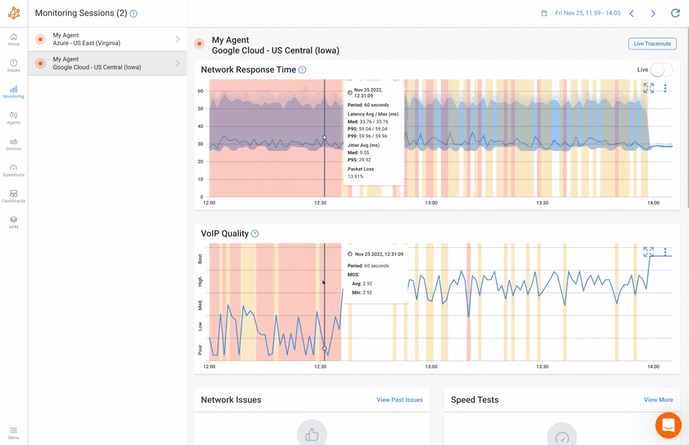

Now that you've learned how to measure bandwidth and identify potential bandwidth issues in your network, it's time to take proactive steps to enhance your network's performance. By implementing these techniques, you can ensure a smooth and efficient network, delivering a seamless user experience and enabling critical applications to perform at their best.
Let's dive in!
- Network Upgrades: Increase the network's capacity by upgrading to higher-bandwidth equipment, such as switches, routers, and network interface cards (NICs). This allows the network to handle more data traffic and deliver faster data transfers.
- Load Balancing: Implement load balancing techniques to distribute data traffic evenly across multiple network paths. This prevents network congestion and optimizes bandwidth utilization.
- Quality of Service (QoS): Prioritize critical applications and services by implementing QoS policies. QoS ensures that time-sensitive traffic, like VoIP or video conferencing, receives sufficient bandwidth, guaranteeing their performance during high network demand.
- Traffic Shaping: Control the flow of data by using traffic shaping mechanisms. This helps prioritize specific types of traffic and optimizes bandwidth allocation.
- Bandwidth Throttling: Apply bandwidth throttling to limit the bandwidth available for certain applications or users. This ensures fair distribution of resources and prevents any single application from consuming excessive bandwidth.
- Content Delivery Networks (CDNs): Utilize CDNs to cache and serve content from servers located closer to end-users. This reduces the need for data to travel long distances and enhances data transfer speeds.
- Compression and Caching: Implement data compression techniques and caching mechanisms to reduce the size of data packets and decrease bandwidth usage.
- Network Monitoring and Analysis: Regularly monitor network performance using network monitoring tools. Analyze bandwidth utilization to identify congestion points and areas that may require optimization.
- Network Optimization: Optimize the network's physical layout, topology, and configurations to reduce latency and enhance data flow.
- Packet Prioritization: Set packet priorities based on application requirements, ensuring that critical data is given priority during transmission.
- Protocol Optimization: Use optimized network protocols that reduce overhead and improve data transfer efficiency.
- Bandwidth Management Policies: Implement effective bandwidth management policies that align with the organization's needs and priorities.
By combining these strategies and tailoring them to your network's specific requirements, you can significantly improve bandwidth and overall network performance, delivering a seamless and efficient experience for users and critical applications.
In conclusion, measuring bandwidth is a fundamental practice in maintaining a high-performing network. By understanding how to measure bandwidth accurately, differentiating between upload and download bandwidth, and utilizing various techniques such as Network Performance Monitoring Software, Speed Test Tools, Network Testing Tools, Command-Line Utilities, Simple Network Management Protocol (SNMP), Packet Capture and Analysis, Internet Control Message Protocol (ICMP) Tests, and Network Emulators, you can gain valuable insights into your network's health and identify opportunities for improvement.
Additionally, correlating bandwidth measurement results with other network performance metrics helps create a comprehensive picture of network performance, enabling better decision-making for capacity planning and optimization efforts. Furthermore, considering the real user experience and assessing how bandwidth utilization affects critical applications play pivotal roles in delivering a seamless user experience and achieving business objectives.
As you strive to enhance your network's performance, Obkio's Network Performance Monitoring tool is ready to take on the task!

With its synthetic, end-to-end solution, you can accurately measure, analyze, and optimize your network bandwidth like never before. Don't wait for bandwidth issues to affect your network's productivity and user experience—take proactive action with Obkio's powerful tool today!
Take the first step towards an efficient network and sign up for Obkio's Network Performance Monitoring tool now.
- 14-day free trial of all premium features
- Deploy in just 10 minutes
- Monitor performance in all key network locations
- Measure real-time network metrics
- Identify and troubleshoot live network problems
Empower your network with real-time insights and unlock its full potential for seamless data transfer and enhanced user satisfaction. Measure bandwidth with precision and optimize your network for success with Obkio.



























 Obkio Blog
Obkio Blog








